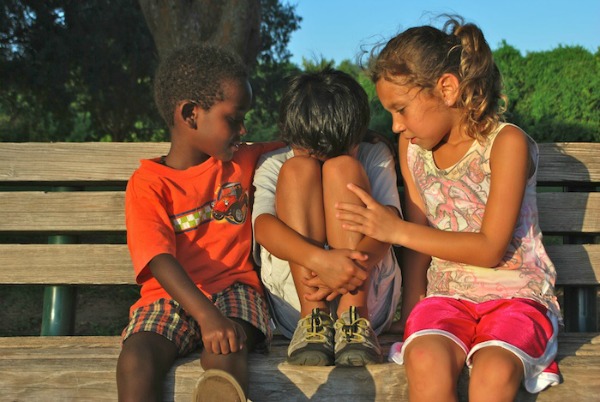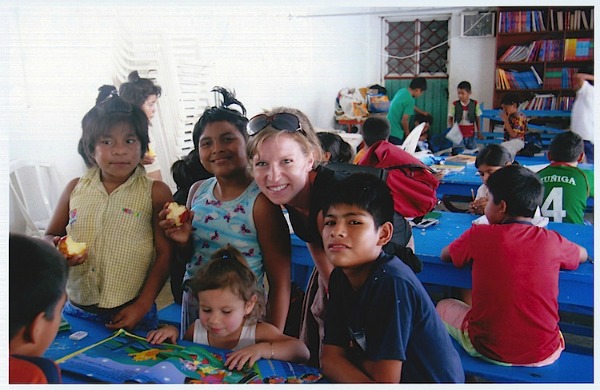My 7-year-old daughter sat at the base of the slide, letting the other kids run by, and watching as they laughed and played. Some older boys got a little too close and she asked them to be careful with their ball: “Please- you’ll scare her…. she’s protecting her babies.” Vivi took her self-appointed position of bodyguard seriously; she wasn’t going to let anyone near the mother duck, who had unfortunately chosen the base of the stairs to lay her eggs. While Vivi participates in the normal sibling and friend squabbles, one of my favorite qualities is her authentic empathy towards others.
I recently read an interesting article from UC Berkley that asked the question “Can empathy reduce racism?” The author discussed a recent study that suggests that the ability to put ourselves in another’s shoes allows us to reduce unconscious biases, and actually enhances the interactions we have with people who look different from us. We are living in an interconnected world, where our children will work and interact with people from a multitude of cultures. If parents want to raise children who are accepting of all ethnicities — and if empathy helps to eliminate racism — how can families teach this compassion to their children as they grow up?
Empathy is the awareness that another person (or any living thing) is suffering. Empathetic children understand the feelings of others and wish to relieve their pain and better their experience. It’s not just that we feel sorry for someone; it’s moving beyond sadness or pity, and aspiring to change it. One way that kids learn empathy is when they learn about other cultures and differing perspectives. Being able to truly understand another person’s point of view shows us that we all have similarities on some level.
How else can parents teach or model empathy? Despite being inherently compassionate, children benefit from witnessing kindness towards others, respect for other cultures and races, and examples of how to stand up for what’s right in the face of discrimination. By modeling compassion and empathy towards our partners, children, friends, and even strangers, we demonstrate how to put feelings into action that helps the person suffering and alleviates their situation. Our children observe how we react empathetically when we assist someone who just dropped their groceries, return a phone left behind, stop a joke based on stereotypes, bring dinner to a new mom, or stick up for kids who are getting picked on.
Another wonderful way to teach kindness by example is by volunteering together as a familia. On a trip to Acapulco, we spent a day at a local children’s home to play with the kids, set up a basketball hoop and help them make Christmas cards. On every visit to Mexico we involve our kids in packing donations for orphanages and schools: what toys would the toddlers enjoy? What school supplies do the kindergarteners need? We try to teach our kids to put themselves in the shoes of others and relate to them as peers.
This year, we visited a couple of local foster homes for refugee children who are unaccompanied minors. Before arriving, I prepared my kids. Their eyes grew serious as I explained that we would be making a craft and sharing a snack with kids who are here without their families. They vowed to help the kids have a fun afternoon — not because they would be rewarded or punished, but because they understood that this was the generous and kind thing to do. Although shy at first, everyone warmed up quickly. Ricky’s silly antics elicited laughter, Vivi’s genuine compliments about the girls’ hairstyles drew shy smiles, Maya respectfully listened to the kids talk, and Tonito and his new friend from the DR Congo found common ground in their interest in cars.
We left the group home feeling inspired and a bit euphoric. As we’ve volunteered more, I’ve seen my children’s empathy begin to develop. They now initiate random acts of kindness, and are a bit more tolerant on the playground and with each other. One day last spring my son came running home from school: “There’s a new boy at school, and he doesn’t know anybody! We have to invite him over so that he can meet some friends!” Though we can’t measure empathy in standardized tests, experiences like these tell us we’re on the right path.
{Photos courtesy of Becky Morales}




This article was wonderfully written and very inspiring. I remember when filling out our son’s baby book it asked “what we would most like to teach you is…”. My husband and I wrote “empathy” on the blank line. This article was a good reminder for me and provided good tips on how to teach and model empathy. Thank you!
Trisha- thank you so much! I completely agree with you:)- my kids might not be the #1 athletes or the valedictorian, but I hope they grow up to be compassionate, empathetic adults.
This article gave me goosebumps. I try to tell my son about poor children who don’t have all of the many blessings he enjoys, but I like the idea of appreciation for other cultures being another way of teaching empathy.
Thank you Sara. Two of my sons are adopted, and come from regions where there is such deep poverty. I have found that it is such an abstract idea to teach kids about poverty when have been blessed with a home, have access to healthy food and water, can go to school every day, etc. I think a part of empathy though is being able to put yourself into another person’s shoes, and try to see things form their perspective. So in a way, these small steps of teaching kids about other cultures is helping them become more empathetic. As they grow up there will be bigger challenges, but we can build on the foundation we give them as little ones:).
This is beautifully written and the examples of your own children and amazing and heart warming. I will certainly be thinking about this and how to better teach/model/discuss empathy with my two girls.
Thank you Erin:). In writing the article, I was reflecting a lot about my every day behavior and how I can model empathy and compassion more on a daily basis. Sometimes I do things (like dropping off a meal for a new mom) and I don’t ever explain to the kids the “why;” but really it’s the perfect opportunity for a quick conversation about taking care of others when they need it.
I liked how you involve your kids in helping other kids. Kids can relate to each other when they are together. I think kids need these interactive experiences to help them learn to be empathetic with other kids. Good article!
Sometimes it’s the easy things, like just modeling compassionate behavior, that helps kids to become more caring and responsible. I also really believe that the more we show respect for and learn about other cultures, the more open and empathetic our kids are.
Awesome post.
prestamos rapidos con asnef